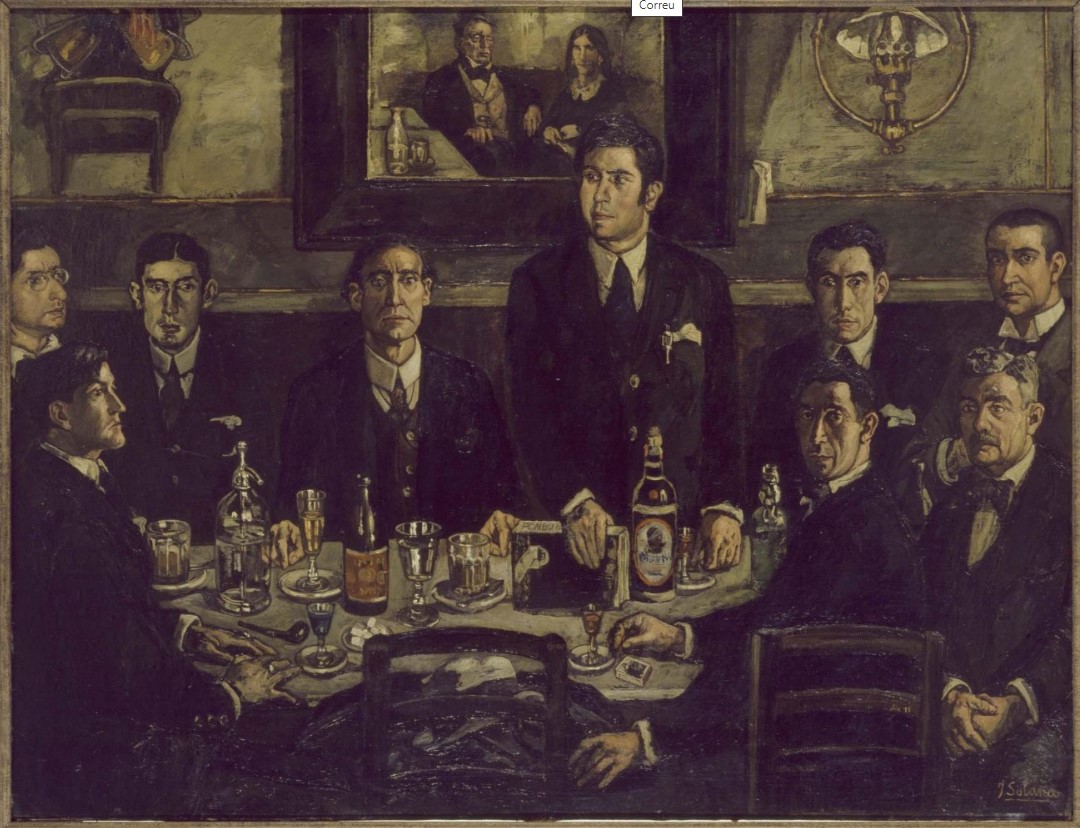- Humanities
- 30 de April de 2024
- No Comment
- 8 minutes read
Portraits of a Gathering: Pombo

Portraits of a Gathering: Pombo
The term ‘plebeian’ referring to Madrid (used by d’Ors in an epigrammatic way) clarifies one of the features of that gathering, which accommodated characters of very varied nature


Eduardo Alaminos
Undoubtedly, the painting by José Gutiérrez Solana, “La tertulia del Café de Pombo” (located at the Reina Sofía Museum), is the most important graphic document about it. It can be affirmed that this work depicts not only the gathering created by Ramón Gómez de la Serna, but also an entire era, that of a certain nonconformist Madrid in the first third of the twentieth century. Domingo Ródenas de Moya (El orden del azar. Guillermo de Torre entre los Borges, 2023) referred to it as a “temple and palestra” and a sphere of “effervescent atmosphere of aesthetic nonconformity”.
The birth of the Pombo gathering in 1915 went along with the release of a “Primera Proclama”, edited as a loose sheet (730 x 535 mm.). There is a facsimile edition published by Poesía. Revista de información poética, No. 3, 1978. We can consider it as a manifesto (so common in the field of artistic and literary avant-gardes of those years), as a notarial deed of its opening and existence and even as an advance of the structure that would have the two books that Ramón, its creator, dedicated to it: “Pombo” (1918) and “La sagrada cripta de Pombo” (1924).
On the front page, the “Proclama” opened with a synthetic image, a line and flat ink drawing by Salvador Bartolozzi in which he depicted eleven seated participants in the gathering wearing top hats and a standing waiter, and a large mirror behind them in which a fragment of a gas lamp from the Café and other forms of difficult identification were reflected based on points. This image, the first of the gathering, serves as a portico to the text addressed to a certain Mr. D… signed by Ramón. A reproduction of the painting by Antonio Gisbert, Fusilamiento de Torrijos y sus compañeros en las playas de Málaga (1888) (Prado Museum), can also be seen, in a clear allusion to the liberalism and heroism of the gathering that Ortega y Gasset would later endorse in a famous speech “son ustedes la última generación liberal”, and finally, a typographic ornament with the names of the founders: Manuel Abril, Salvador Bartolozzi, José Bergamín, Rafael Bergamín, Tomás Borrás, Rafael Cansinos-Assens, José Gutiérrez Solana, Ramón Gómez de la Serna, Gustavo Maeztu, Diego Mª Rivera, Rafael Romero Calvet and José Cerezo (“waiter of our chapel”), eleven names as in Bartolozzi’s drawing.
On the back of the sheet were included a card from Ramón with his “monogramed silhouette”, as Ramón himself defined it, made by the sculptor Julio Antonio; two references of place and time: “Saturdays /night” and “Old café and liquor store of Pombo”; Ex-libris made by the architect Rafael Bergamín; a drawing of the Pombian lamp in the shape of a lyre that would become the logo of the Café, which Alfonso Reyes described as a “subtle drawing of the gas spider” and which Ramón would include as a letterhead at the top of his letters. Finally, preceding the printer’s information, a notice that read: “Beautiful words have been said about our Pombo by COLOMBINE in El Heraldo and XENIUS in La Veu”.
These two literary references (since literary matters also contributed to shape the image of the Pombian gathering) can be considered, along with the images and texts of the “Proclama” itself, as the first literary portraits that were written about Pombo. I will start with the one by Eugenio d’Ors, titled “Epigrama del Pombo”, published in “La Veu de Catalunya” on June 16, 1915, no. 5,790, pg. 1, edició del Matí.
As Andreu Navarra has pointed out, “in Madrid, d’Ors did not miss a gathering, party or commemoration (…) he could often be seen at the gatherings of the “movimiento ultraísta” (…) and he also attended regularly the fundamental gathering of Pombo, where he was highly respected” (La escritura y el poder. Vida y ambiciones de Eugenio d’Ors [2018]). I am interested in highlighting several images from d’Ors’s gloss in “La Veu de Catalunya”: the first, in which d’Ors portrays Pombo’s nightlife at eleven in the evening as “a pearl held by a somber romantic bow on the beautiful plebeian and lively neck of Madrid”. Xavier Pla, when commenting on the Eugeni d’Ors’s gloss, concludes that “Pombo, the pearl of Madrid, was there to be seen and shown, even to ‘sweat it’, so that it could shine delicately and softly every evening” (“De Ramón a Eugenio, de Buenos Aires a Madrid. Unas cartas inéditas”, Revista de Occidente, No. 481, 2021). In contrast to other Cafés that d’Ors considered as diamonds, Pombo conceived it as a pearl, but we must not forget that the term pearl can also be used ironically.
The term “plebeian” referring to Madrid (used here by d’Ors in an epigrammatic way) clarifies one of the features of that gathering, which accommodated characters of very varied nature, as opposed to, for example, the limited and elitist gathering of the “Revista de Occidente”, created by Ortega y Gasset, and recently studied by Juan Manuel Bonet, Fernando R. Lafuente and Fernando Castillo (Catalogue of the exhibition Revista de Occidente o la modernidad Española [2023]). D’Ors perceived the Pombian gathering as a centre of agitation with respect to that cultural context that Ramón denounced at the beginning of the “Proclama”: “everything is becoming more clumsy, more entangled, more insidious and more reactionary”. He considered the gathering as a collective being, the plebeian, or if you prefer “lo castizo” (the traditional, authentic) and associated it with certain romantic traits, two axes that Ramón knew how to reconcile admirably, linking them without continuity, with other attributes of the nineteenth century: the popular, the defence of modernity and the exaltation of the new.
The second Dorsian image, and this one seems to me perhaps even more interesting as a conceptualization of the gathering, is to consider that Pombo resembles “the colour of a certain display case, the Carnavalet, a museum in Paris, equally full of romantic memories”. But he adds that this romantic pearl of Paris is confined and overly sheltered”. Why does d’Ors cite this museum? The Carnavalet Museum (inaugurated in 1882) was founded following a suggestion by Baron Haussmann a year before the major urban reform of Paris (1865. The museum’s aim was to collect any pieces that the urban reform would inevitably cause to disappear.
Therefore, “La sagrada cripta de Pombo” was considered by d’Ors as the gatherings’ Carnavalet, but less modest because of the character of the city, Madrid. If so, the two books that Ramón dedicated to it could be visualized as display cases loaded with memories, testimonies and anecdotes.
Source: educational EVIDENCE
Rights: Creative Commons

